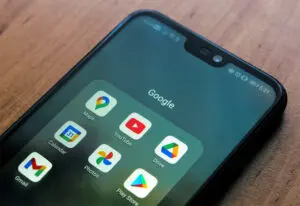
Move Over Wi-Fi. How the 5G Network Is Already Impacting the Digital Marketing Space
When you think of “the Cloud,” you might picture your documents, photos, and music floating around cyberspace waiting for you to access them from device to device. The 5G network is the latest wireless advancement that uses the Cloud to make things faster and easier to access. But this advancement has big impacts on digital marketing. To name a few: increased use of virtual reality, mobile e-commerce, and a better customer experience.
The difference between 4G and 5G
In a way, 4G and 5G are simple concepts––they stand for the generation of wireless networks. That said, 5G is the fifth generation of the network that connects the Internet of Things (IoT). The biggest difference between the two is that 4G requires physical cables and infrastructure. Whereas “5G’s cellular towers amplify cloud-based signals which eliminate many cable-related needs.” 5G is also a licensed network, so it relies on cellular providers’ signals from cell towers.
5G brings many possibilities to the market with its four defining factors.
Speed: 5G is 100 times faster than 4G. This means that you can do things like “download a two-hour film in fewer than 10 seconds.” Or a customer could rapidly download apps or watch brand videos.
Capacity: The newest wireless generation also takes away the congestion concern. It can handle more people on the network all at once, which ends frustrating lag times and captivates users quickly.
Latency: Latency refers to the the time devices communicate with a server. With 5G, latency is non-existent. And this instantaneous communication can help brands reach customers.
Reliability: Lastly, the network has the potential to be extremely reliable. And this will only improve as more cities adapt to 5G.
Why it matters
So, what are brands’ relationships with these wireless networks? You don’t need to look further than modern services like Uber and Lyft to understand the impact wireless networks have. Brands are no longer limited by strictly in-person interactions. They’re dynamic, convenient, and fast-paced. With 5G leading to innovations in smart cities and automation, it’s also changing the future of digital marketing.
How 5G impacts digital marketing
The four defining factors of 5G can disrupt a lot of industries. And marketing is no exception. A key factor of the newest network is that it will “amplify many of our current digital strategies while allowing us to explore more technological opportunities.” As a marketer, you should continuously watch for new trends like 5G to better prepare your brand. These trends also help you understand how your customers consume data. And while many of the changes are still yet to be seen in digital marketing, here are four ways 5G impacts your brand:
Advertising is more interactive
As smartphones have advanced, marketers have had to up their game. Now, consumers want brands to be interactive and advertising to engage them. A recent study found that people spend 47 percent more time with interactive ads. 5G makes it so that marketers can more easily “deliver enhanced advertising experiences—ranging from augmented to virtual reality.” These one-of-a-kind experiences can change the customer journey to multiple, cyclical touchpoints that mean your users are always ‘on.’
Augmented reality, for example, gives consumers the ability to ‘try before buying.’ Such as IKEA Place, the augmented reality app that lets potential customers see how furniture will look in their home before they buy. Virtual reality’s applications are likewise endless. A perfect example is Mountain Hardwear, which shows “true-to-size products like tents and sleeping bags in an immersive environment.” Another way digital marketers can create interactive ads with 5G is with 3D Swirl, “an immersive display format with an interactive 3D model. It delivers high impact on brand awareness and purchase intent via an innovative 3D experience.” Any one of these applications creates a uniquely interactive experience for consumers that can bring marketing to life. Even as we trend toward socially distanced buying.
Online presence is more important
Unsurprisingly, 5G’s benefits and prevalence make it so that brands without a robust online presence (or without one at all) are pretty much in the marketing Dark Ages. With 5G, “every device will be a mobile device” and lack of wires means that even people in remote locations will be able to access the web. So with more consumers on the IoT than ever, your brand will have a larger and broader audience. And an online presence is the key to engaging them.
People will now “spend more and more time logged on to the internet and less time consuming traditional content, like cable TV, newspapers, and magazines.” This also means you have to create an online presence that keeps consumers engaged in an increasingly competitive market space. To do this, you’ll need to strengthen your social media presence and update your website with SEO-rich content. You should also publish a regular blog and invest in the newer interactive mediums.
Offers a better user experience
5G makes it so digital marketers can optimize the user experience. Its speed, precision, and capacity allow marketers to “provide more personalized experiences, while also ensuring consumer privacy is respected.” Prioritized consumer privacy also means more consumer trust and, ultimately, engagement. Plus, with basic trust in place, brands can focus on creating content that’s engaging, impactful, authentic, and memorable.
Some ways brands can achieve this is by offering “hyper-personalized content delivery, high-bandwidth digital experiences, faster websites.” Not only can consumers expect a faster, more seamless experience with brands, but 5G also allows for better targeting and more individualized content. This “amplified data-informed targeting” does away with the one-size-fits-all restrictions of traditional marketing. Things like Warner Media Ride exemplify the increased customer experience with the collaboration of 5G connectivity and in-vehicle entertainment.
With the combination of immersive technologies, high speeds, precise-targeting, and enhanced privacy, 5G makes the user experience better than ever. So, “the value exchange for consumers and marketers is tangible.”
Increases mobile e-commerce
According to Adweek, “70% of consumers say connected processes––such as contextualized engagement based on earlier interactions––are very important to winning their business.” For mobile e-commerce, that means your brand needs to market to consumers where they are and use the precise targeting 5G allows. Creating digital marketing based on earlier interactions requires taking advantage of 5G’s speed and use of interactive technologies.
A recent study predicted there will be “eight billion people online by 2024.” And more customers equals more revenue and touchpoints for brands. With 5G offering more accessible and pleasant mobile experiences, it’s no surprise that these consumers will turn to online shopping from their phones. Especially in the wake of 2020, mobile e-commerce is a digital marketing step your brand won’t want to miss. It’s also something that 5G makes all the easier and more precise.
What your brand can do to keep up
Your brand’s biggest way to keep up with 5G is to study the trends and stay ahead of the curve. Your first step is understanding how 5G impacts digital marketing. Then you can invest in technologies like VR or AR and use precise audience targeting. Keep up-to-date by watching big brands and observing how their campaigns change. Overall, “this will help you identify which opportunities might be more accessible to you in the future.”
By upgrading your online presence from blogs to social, you can keep up with the 5G network. Another way to boost your online presence? Craft content with “AR or new-media filters on apps like Snapchat, TikTok, or Instagram.” The bottom line with any advancement is to stay in communication with your customers. See what platforms they’re using, how they’re accessing their favorite brands, and where they are. It’s also essential to maintain your brand’s core values despite adapting to the changes 5G will bring. When your brand remains consistent but relevant, you’re more likely to keep your brand fans. And create new ones in the process.
The agency touch
New technologies that impact digital marketing emerge all the time. The latest that’s becoming more prevalent is 5G. With increased speed and precision, it’s making digital marketing a more immersive user experience. Not to mention solidifying the importance of a stellar online presence. As a digital marketing agency, Savy keeps ahead of trends like 5G so we can serve our clients better and help them craft content that’s memorable and lasting. Can your brand afford to wait? Let’s go.
Recent Posts
How to Rebrand Your Instagram for Better Engagement and Brand Recognition
Your Instagram presence can act as a beacon for brand recognition and customer engagement. It’s about painting a picture so compelling that your audience cannot help but be drawn to […]
Read MoreFrom Clicks to Conversions: The Science of High-Performing Digital Ads
The journey from interest to purchase is often paved with digital advertisements. However, not all digital ads are crafted equally. While some fade into the background, others command attention and […]
Read MoreBrand Consistency Examples That Will Make You Rethink Your Marketing Strategy
A consistent and strategic brand identity across all platforms is not just beneficial; it’s essential. By exploring real-world brand consistency examples, we uncover the immense power of maintaining a coherent […]
Read More3 Ways to Transform Blogs With SEO and Make Google Love Your Content
As marketers and business owners, our goal is to ensure the blogs we publish confidently stride into the spotlight of Google’s top search results. Achieving this requires great content, but […]
Read More



